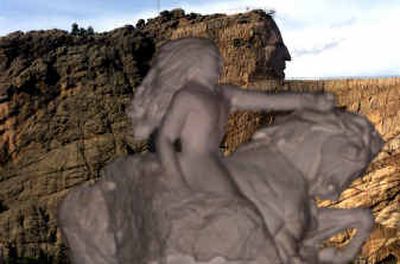Crazy Horse memorial progress slow but steady

CRAZY HORSE, S.D. — He never let anyone take a photograph of him during his lifetime. But today, the face of Crazy Horse looks out upon the South Dakota landscape for all to see.
Far larger than life, the stone visage of the 19th-century Sioux chief is the only completed feature of what will be the largest sculpture in the world. Already his 87-foot-high head is bigger than the entire carvings of the four presidents at Mount Rushmore 17 miles away — and that’s only a fraction of the total work.
No timetable has been set for the completion of the Crazy Horse Memorial, but the work continues without letup.
Every day when the weather is suitable, family members of the late sculptor Korczak Ziolkowski can be seen on the mountain, shaping the granite with explosives and laser cutters. When they are finally finished, Crazy Horse will be seen astride his horse in a monumental carving 641 feet long and 563 feet high.
“There’s no way to tell when it will be finished,” said Ruth Ziolkowski, the sculptor’s 77-year-old widow, who has run the project since her husband died in 1982. “The dream is there. We just keep on working.”
It’s an enormous undertaking, made more so because the Ziolkowski family has steadfastly refused to accept proffered monies from government bodies, twice turning down offers of $10 million. The work is financed solely by admission fees to the visitor center and private donations.
When I first visited the Crazy Horse Memorial in the summer of 1982, more than 7 million tons of rock had been removed from the mountain — 18 times more than all of Mount Rushmore — but there was little to see.
Most visible was the hole that had been blasted through the mountain; it is to become the space between the chief’s outstretched arm and his horse. What will become the head of the horse was outlined with 176 gallons of white paint on the mountain’s flank, and in the valley below was a small visitor center and the modest home of the sculptor and his family.
Today, workers are beginning to shape the horse’s head, and the visitor complex below the sculpture has grown to include a large, pine-paneled museum of Indian lore and artifacts, a restaurant, exhibit halls, cultural center and gift shop. A key object is the 1/34 -scale plaster model of the sculpture that stands on the viewing terrace of the visitor center. More than a million people visit the project annually.
Among the museum’s displays are 26 of the original beads that bought the island of Manhattan in 1626, two pipes owned by Chief Sitting Bull, a collection of Old West prints by photographer Edward Curtis, and historic Indian headdresses, blankets, buckskin outfits and beaded moccasins. The gift shop carries goods made by Native Americans.
But even these elements pale beside Ziolkowski’s grand plan for the complex. If completed the way he envisioned, the Crazy Horse Memorial will also encompass an Indian University of North America, a medical training center, an airport, a much larger Indian Museum and an Avenue of the Chiefs lined with sculptures of Native American leaders, all in the shadow of the world’s largest sculpture.
It’s all a part of Ziolkowski’s dedication to the betterment of Native Americans. The sculptor created a scholarship program for Native Americans that has given more than $500,000 since its inception 25 years ago, and Native Americans are not charged admission to the memorial.
The memorial’s proximity to the monumental carvings at Mount Rushmore is no accident. Sculptor Ziolkowski had worked for a time with Gutzon Borglum on the Rushmore project and knew the area well. He also was an established artist, having won an award for a bust of Polish pianist and President Ignace Paderewski at the 1939 New York World’s Fair.
That same year Ziolkowski received a letter from Sioux Chief Henry Standing Bear, asking him to carve a memorial to the American Indian.
“I would the White Man to know the Red Man has great heroes, too,” the chief wrote.
After military service during World War II, Ziolkowski accepted the invitation, acquired the mountain and set off the first dynamite blast in 1948. Work on the project since has been continuous though slow.
Ziolkowski married and raised 10 children while working on the project. Seven of them, plus some grandchildren, work at the complex.
The man honored by the sculpture, Crazy Horse, was both a visionary leader and legendary warrior. “Crazy Horse defended his people and their way of life in the only manner he knew,” Ziolkowski wrote in 1949.
After the United States broke the Treaty of 1868, Crazy Horse fought the white man’s encroachment successfully in several battles, including the 1876 Battle of Little Bighorn, also known as Custer’s Last Stand. “My lands are where my dead lie buried,” he once declared.
The Indian leader finally surrendered to U.S. forces in 1877 but died at age 35 later that year when a soldier bayoneted him while another soldier held his arms.
Completion of the monumental statue may not atone for the treachery that resulted in Crazy Horse’s death but certainly will bring the story of a proud people to the attention of millions.
Sculptor Korczak Ziolkowski had a strange relationship with Crazy Horse. The Indian chief was slain on Sept. 6, 1877, the same day Ziolkowski was born 31 years later.
“The Indians believe Crazy Horse’s spirit roamed until it found a suitable host — and that was Korczak,” said his wife, Ruth.